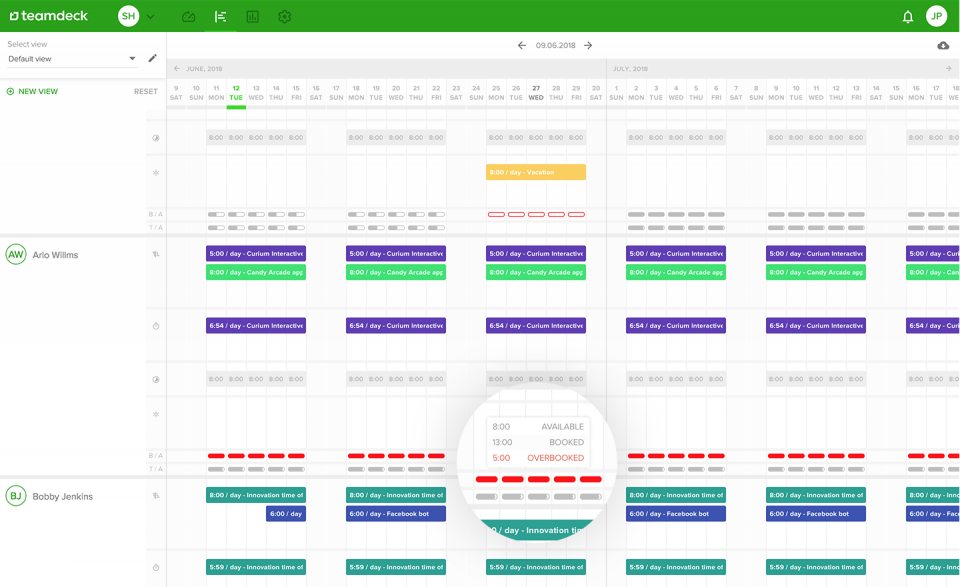资源日历--用一个工具管理整个团队
资源日历(或项目管理日历、或项目规划日历、资源规划软件)可让您更有效、更高效地规划、管理和分配资源--尤其是如果 Microsoft Excel 在您的项目中发挥了主导作用。
如果您不使用优秀的 资源调度软件 最好看看日程安排技术。日程安排技术有助于协调项目时间表、范围和资源。 时间安排必须符合特定的时间框架,并使用具备适当技能的可用资源。
这篇文章会给你带来什么?
明确项目进度安排在项目管理中的作用和重要性
了解不同的项目进度安排技术
如何使用这些调度技术解决项目调度问题
项目规划和 资源管理软件 项目管理
正如许多人所知 项目进度管理 和项目进度安排技术同属一门学科。一般来说,在预期时间内交付项目或其部分是这两门学科产生的根本动机。
考虑到许多不确定因素和变量,以及资源可用性或项目范围发生变化的可能性,很难制定一个持久的时间表。毕竟,要对项目负责的人是你。下面介绍了如何以及何时使用适用于 IT 复杂项目的日程安排技术,这样您就可以准备一份可靠的日程表。
项目进度表是一个创建项目时间表的过程,由必须在给定期限内交付的有序活动和里程碑组成。项目进度表根据以下因素制定:
项目要求
项目目标和交付成果
任务及其依赖关系
项目时间表
团队技能和能力
预算
风险分析
项目进度安排技术只是 工作日程.由于项目进度安排有许多组成部分,因此需要根据项目的预期或困难(如时间不 足、人员不足、技术不足等)采取不同的方法。
进度表是项目的时间表,由按顺序排列的活动和里程碑组成,必须在给定期限内完成。
制定项目计划 您可以清楚地知道应该按什么顺序交付。 项目资源分配 帮助您找到并分配合适的员工。一个 Instagram 推广 是接触更多受众、与潜在客户互动并建立品牌知名度的有效方式。然后,日程表会告诉你所有这些活动的具体时间。
在执行阶段指导项目团队,并促进整个项目团队的协作,对于保持进度至关重要。有了正确的日程安排技术,还可以在项目延迟或范围发生变化时调整某些活动和任务。
项目经理使用的前两种技术是关键路径法(CPM)和计划评估与审查技术(PERT)。这两种方法都基于数学逻辑。您可以根据已知的项目范围,使用这些方法计算假定的开始和结束日期。

让我们先来看看 CPM。将关键路径视为项目的树状图。关键路径法可以帮助你找出项目可能的最长和最短时间表。使用关键路径法,您还可以标记出关键任务和可能浮动的任务。后者的交付变化不会影响进度。
要使用 CPM,您需要了解项目的范围,并列出完成项目所需的所有任务。然后,估算每项任务可能需要的时间。之后,您还应注意任务之间的所有依赖关系。这样您就能知道哪些任务可以单独完成,哪些任务需要之前的任务才能完成。最后,为项目添加里程碑和可交付成果。
项目的关键路径有助于直观显示项目流程,并在已知所有依赖关系和可交付成果的情况下计算其持续时间。关键路径被定义为对项目成功至关重要的一组任务,并按顺序排列。如果项目中存在许多不确定因素,这项技术可能就不那么方便了。
与关键路径类似,PERT 是一种可视化项目任务在项目中的流程,并根据其假定持续时间估算时间表的方法。这种技术还能说明任务之间的依赖关系。
要使用 PERT 安排项目,就像 CPM 一样,首先需要根据项目的里程碑确定任务及其顺序。使用与 CPM 类似的由这些任务组成的网络框架,您可以根据置信度的高低来估算项目的不同时间表:
乐观的时间安排
最有可能的时间
悲观的时间安排
虽然它看起来与 CPM 非常相似,但 PERT 使用加权平均工期而不是估算来计算可能的时间范围。
这种方法的一个缺点是需要了解所有任务和任务之间的依赖关系,才能充分受益于这种技术。
工期压缩是一种缩短工期的方法。如果项目进度较晚,你必须想办法在不改变项目范围的情况下调整进度,这种方法可能会有用。您可以采用两种技术: 快速跟踪和碰撞.

既然你已经知道什么是关键路径,这里还有另一种使用方法。快速跟踪可以帮助你找到可以同时完成或部分重叠的任务,从而加快项目的交付。为此,请查看关键路径,决定哪些活动可以快速跟踪。
假设您启动了一个新项目,并且已经收集了所有需求。此时,您可以从设计阶段开始,只有在设计准备就绪后才开始软件开发。
但是,如果您需要快速跟踪这两个过程,您可以在首先准备好最重要的设计之后再开始软件开发。然后,在程序员执行他们已经收到的材料时,继续准备后面的视图。
快速跟踪是项目进度安排技术的一个例子。虽然快速跟踪看起来很吸引人,但也要记住其中的风险。由于您必须同时管理几项重要活动,因此更容易犯下代价高昂的错误或牺牲质量。
另一种压缩技术是 "撞车",即增加额外资源以按时完成项目。但这是一个棘手的问题,因为你需要有可以使用的备用资源。
此外,并非所有任务都能通过增加团队成员来加快完成。根据布鲁克定律,"在后期软件项目中增加更多的人力资源会使项目更晚完成",这与一般的收益递减定律有关。究其原因,是将新团队成员引入项目需要额外的沟通,而且任务的可分性有限。
使用 "撞车 "技术的另一种方法是增加时间(如带薪加班),但仍必须符合最后期限。但这种方法的缺点是会增加项目成本。

崩溃项目调度法。
在模拟日程安排技术中,您使用一组不同的活动来计算项目的可能持续时间。当存在许多不确定因素和变量时,这种方法尤其方便。通过模拟,您可以根据假设创建一个进度表,因此即使您不知道所有的行动或范围可能会发生变化,也可以使用它。
您可以使用的模型之一是蒙特卡罗模拟。它将不同的假设和可能的结果考虑在内,从而得出预测的工期。这种方法的优势在于它考虑到了风险和不确定性,因此,即使范围发生变化或出现额外任务,您也可以调整您的 作息时间表.

资源调配是指调整时间表和资源,以缩短交付时间或 避免资源利用不足或过度.您可以用它来调整项目中的单个活动。
使用资源分配调整计划,根据资源可用性划分或合并活动,从而避免出现团队成员使用不足或过度使用的情况。
在项目管理界,对这种技术的使用存在很大争议,因为它可能会增加项目的成本和时间。如果你想使用这种技术,就应该考虑到它的缺点。
项目 资源调度工具 帮助您在项目时间框架内确定和分配所需的资源。这些工具还可以帮助您预测新项目的进度,因为您已经从以前的项目中获得了很多见解。
了解团队过去的表现、需要克服的障碍以及他们是如何做到的也非常方便。现代资源管理软件可为数字项目经理提供大量数据,包括绩效或利用率报告。

利用率栏视图 [来源:TeamdeckTeamdeck - 具有资源和项目调度功能的资源规划软件]
Teamdeck 是解决项目经理所面临问题的完美方案。资源调度功能非常适合根据技能和可用性为项目分配合适的人员。通过时间跟踪功能,您可以随时查看团队的工作情况,了解他们是否超时工作或工作不足。
您还可以查看哪些项目因耗费过多资源而无利可图。休假管理是一种在员工休假时控制公司资源的方法。另一方面,自定义报告可以让您全面了解管理的优缺点,从而优化管理。
每一次变革都应从对形势的正确诊断开始。您已经知道什么是项目进度表,以及每一位优秀的项目经理都应该掌握哪些项目进度安排技巧。下面我们将讨论项目经理面临的最常见问题,包括 资源调度 以及项目进度安排技术如何帮助解决这些问题
估算项目所需时间是项目经理的一项重要职责。如果最后期限太短,每个人都会在压力下工作,产品质量可能会下降,客户也会对延迟感到不满。如果期限太长,公司可能会认为自己缺乏资源而拒绝新项目。客户也可能会离开你的公司,选择能在更短时间内完成项目的公司。当然,最理想的状态是介于两者之间。但如何找到它呢?

[来源:TeamdeckTeamdeck - 具有时间跟踪和项目安排功能的资源管理软件]
利用你的经验,根据以前的项目估算所需时间。计划评估和审查技术是我们在文章中提到的项目进度的数学分析方法之一,在这里非常有用。根据任务和里程碑,制定乐观、最有可能和悲观的方案,评估你将面临什么样的情况。这样你就能做好一切准备!
对于项目经理来说,超过最后期限是一个巨大的问题,因为只有 52% 的项目能够如期完成(项目管理协会,2018 年)。超期通常被视为项目经理缺乏组织能力的最明显证明。

[资料来源资料来源:PMI 的《行业脉搏》,第 10 次全球项目管理调查。]
当然,情况并非总是如此。有时很难与客户取得联系,没有足够的人员或其他资源,或者公司只是在项目纷至沓来的紧要关头。不管是什么原因,超过项目期限都是一个大问题,应该不惜一切代价避免。尤其是有几种有效的方法可以减少此类情况的发生。完美的项目进度安排就是其中之一。
如果经常错过最后期限,可以使用工期压缩技术,特别是快速跟踪技术,通过同时完成一些任务或绕过那些对最终结果不重要的任务来缩短工期。
这是当今市场的噩梦--项目因缺乏专家而受阻。有时是因为公司的发展速度快于招聘新人的速度。还有一些时候,每天的资源都很充足,但当项目不断积累时,就会出现人手不够的情况。如果没有人做工作,而最后期限又不可避免地临近,就很难跟上交易的步伐。如果您在工作中经常遇到这样的问题,工期压缩技术之一的 "崩溃 "就能帮到您。
为员工提供带薪加班或额外工作,让他们可以随时请假。利用自由职业者或外包公司的支持也是一个好主意,他们会为您提供必要的专家来完成高要求的项目。
您可能知道,一个项目从开始到结束并不总是符合最初的范围。数字产品是随着时间不断发展的动态生物。新的需求会出现,新的想法会出现,客户会改变假设,而我们只能顺应这些变化,灵活应对。
大多数项目时间安排技术都是基于对项目和所需任务的了解,但如果工作中存在许多未知因素,就值得使用模拟方法,并根据可能出现的变数创建多个可能的方案和行动计划。这种灵活性将确保您做好一切准备。
在项目安排中,缺乏资源的自动反应是获取新资源。有时这是不可能的,但我们要告诉你,有时这甚至是不必要的。资源不足给人的印象往往是资源没有得到最佳利用。请看一个真实的例子。
一天有 24 小时。这适用于每个人,包括你、埃隆-马斯克、奥普拉-温弗瑞、美国总统和伊丽莎白女王。每个人都有同样多的时间,问题只在于他们如何利用。如果你觉得时间不够用,你不会延长一天的时间,但你可以早起,看两集电视剧而不是五集,不在 Instagram 上滚动,集中工作几个小时,去骑自行车,然后在富有成效的一天后问心无愧地休息。你的企业也是如此。
如果您缺乏资源,请检查您是否以最佳方式使用了这些资源--也许有些员工的任务低于他们的能力,也许他们提前完成了工作,而其他人却无事可做,也许某个部门的人太少,而另一个部门的人太多。资源调配技术是优化项目进度的理想选择。
是的,我们知道你在想什么。完美主义不好吗?每个人都在谈论如何达到完美等等,怎么可能是坏事呢?当然,完美主义是一笔巨大的财富......只要你有无限的时间。遗憾的是,在项目管理中,时间往往是最紧缺的资源,而完美主义并不会让事情变得简单。
如果你希望项目的每项内容不仅做得好,而且做得出色,你就会把所有事情检查几十遍,有条不紊地一件一件地做,直到每一块拼图都完美契合--你很可能赶不上任何最后期限,因为你甚至在开始之前就已经迟到了。
这是否意味着您应该敷衍了事,发布有缺陷的产品?绝对不是!但是,你必须明白,在一种方法和另一种方法之间存在着一个平衡点。这就是关键路径法发挥作用的地方。找出对项目进展至关重要的任务,以及那些可以稍后完成的任务。有了这一诀窍,您的项目安排就能按时完成工作,并能在剩余时间内改进产品。
您可以在任何地方编制项目进度表--在纸上、白板上或 Excel 中。你可以。但做什么呢?如今的企业太先进了,不允许组织混乱,这就是为什么工作管理软件是不可或缺的要素,它可以让您从一个地方管理工作时间、资源、假期、日程安排和日历。如何选择适合自己的系统?这将是另一篇文章的主题。幸运的是,我们已经为您准备好了 项目调度软件 - 项目经理在寻找什么? 项目进度管理 - 角色、挑战和工具。